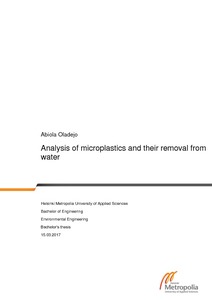Analysis of microplastics and their removal from water
Oladejo, Abiola (2017)
Oladejo, Abiola
Metropolia Ammattikorkeakoulu
2017
All rights reserved
Julkaisun pysyvä osoite on
https://urn.fi/URN:NBN:fi:amk-2017053111371
https://urn.fi/URN:NBN:fi:amk-2017053111371
Tiivistelmä
Removal of microplastics from water was studied using extraction with oil. The aim of the thesis was to remove microplastics from water using an organic medium, and to analyse the amount of microplastics in the media involved. The separation of different microplastic types was done by conducting experiments in the laboratory. The microplastics were made by grinding and sieving plastics with a grinding machine before adding them to water and oil, which serves as the organic medium.
Two experiments were done: in Experiment 1, the microplastic solution was not mixed in the oil solution, and in Experiment 2, the solution was mixed vigorously in oil. The resulting solution then underwent separating funnel method for separation into two phases. The water phase was filtered in order to know the amount of microplastics in the water medium. The analysis of the amount of microplastics in the water medium was done by weighing the mass of the filter paper containing the microplastics substrate after drying. Replicate experiments and measurements were done.
Results show that microplastics could be successfully extracted from water by the filtration method. However, when the polystyrene microplastics in water were mixed vigorously in the oil (Experiment 2), more polystyrene were cleaned from the water by the oil. This observation was supported by the results of the quantitative analysis, which indicate that an organic medium can be used to clean high density microplastics to some degree.
Two experiments were done: in Experiment 1, the microplastic solution was not mixed in the oil solution, and in Experiment 2, the solution was mixed vigorously in oil. The resulting solution then underwent separating funnel method for separation into two phases. The water phase was filtered in order to know the amount of microplastics in the water medium. The analysis of the amount of microplastics in the water medium was done by weighing the mass of the filter paper containing the microplastics substrate after drying. Replicate experiments and measurements were done.
Results show that microplastics could be successfully extracted from water by the filtration method. However, when the polystyrene microplastics in water were mixed vigorously in the oil (Experiment 2), more polystyrene were cleaned from the water by the oil. This observation was supported by the results of the quantitative analysis, which indicate that an organic medium can be used to clean high density microplastics to some degree.
